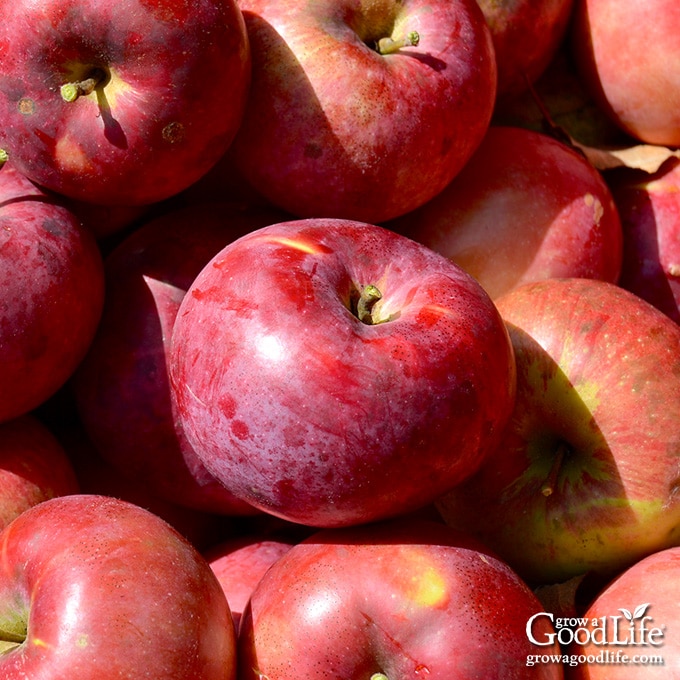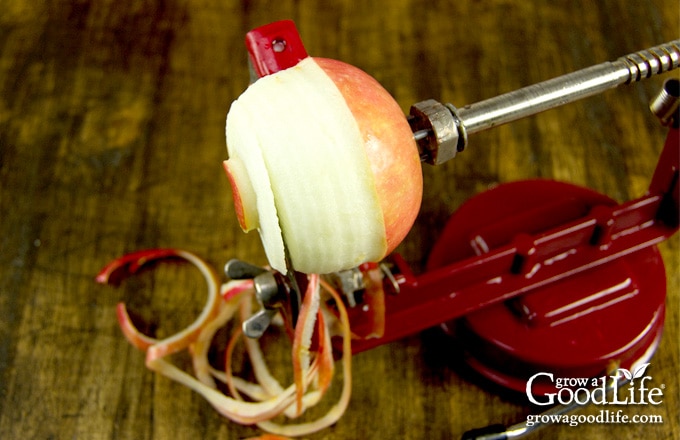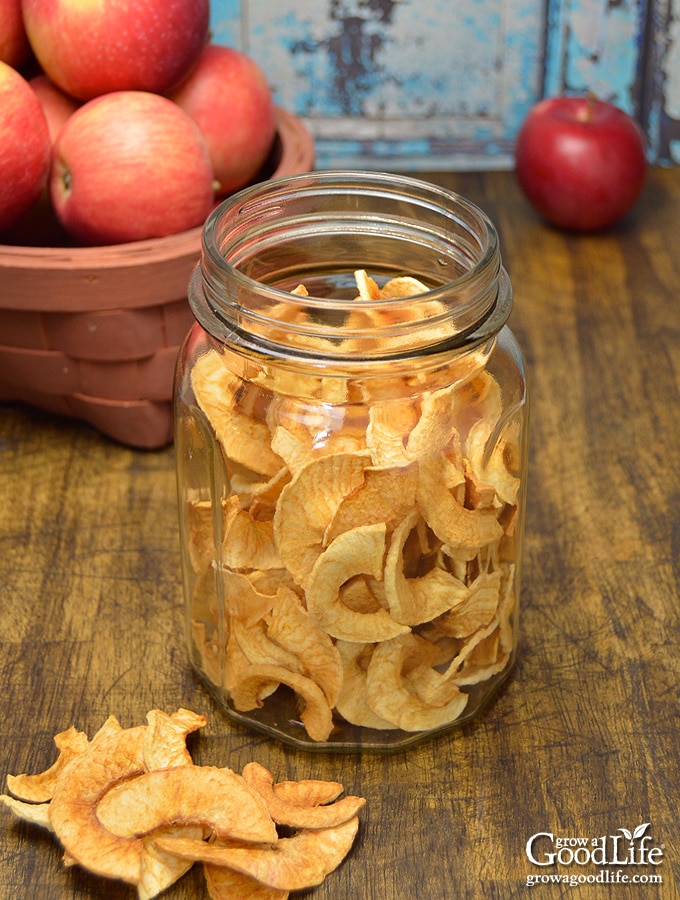Ways to Preserve Apples: How to Store, Freeze, Dry, and Can
This post may contain affiliate links, which means that I may receive a commission if you make a purchase using these links. As an Amazon Associate I earn from qualifying purchases.
If you’re wondering how to preserve apples for winter, there are many different preservation methods to choose from. In this guide, we’ll look at the best ways to preserve apples from short-term storage to canning.

The leaves are falling, the air is crisp, and pumpkin spice has taken over. Fall is one of my favorite seasons, and with it comes apple season.
We have a small apple orchard on our property. Sometimes, the fruit isn’t great because we don’t spray our trees, and those apples are left to feed the wildlife. But other years, when conditions are just right, we’re blessed with a bumper crop of delicious apples.

If you’ve ever gone apple picking with family or friends, you know how easy it is to come home with more apples than you can eat fresh. After enjoying your share of pies, crisps, and applesauce, it’s time to think about preservation so the rest don’t go to waste.
Whether you are picking fruit from your own apple tree, or dealing with an abundance from the u-pick orchard, there are many ways to preserve apples so you can enjoy their flavor long after the harvest. In this guide, you’ll find tips for storing, freezing, drying, and canning apples, plus links to step-by-step tutorials for each method.
Tips for Preserving Apples
There are thousands of varieties of apples available across the nation from backyard trees, u-pick apple orchards, local farm stands, and grocery stores. Here are some tips for achieving good-quality apples when preserved.
Match the Right Variety to Preservation Method
- Storing Apples: While most apples can be kept for a short time in the fridge, long-term storage in a root cellar requires firm, tart varieties with thick skins. Good keepers include Fuji, Granny Smith, Honeycrisp, McIntosh, Northern Spy, and Rome.
- Freezing Apples: Choose hardy apples with a dry, firm texture that will hold up without turning mushy. Cortland, Empire, Granny Smith, Golden Delicious, Jonagold, Jonathan, and Rome Beauty are all good choices.
- Drying Apples: Almost any variety can be dehydrated. Tart apples like Cortland, Gala, Granny Smith, and McIntosh intensify in flavor when dried. Sweet varieties such as Golden Delicious, Honeycrisp, and Red Delicious taste like candy once dehydrated.
- Canning Apples: For canning apple slices, crisp baking apples that retain their shape are best, such as Braeburn, Cortland, Fuji, Gala, Granny Smith, Honeycrisp, Honey Gold, and Pink Lady. Mixing several varieties gives great flavor.
- Apple Jelly and Jam: Tart apples with plenty of natural pectin are the best apples for making jelly or jam. Try varieties such as Granny Smith, Jonathan, McIntosh, or Rome. Crabapples are especially high in pectin and perfect for jelly-making.
- Applesauce and Apple Butter: Any variety can be used, but Gravenstein, Golden Delicious, Jonathan, McIntosh, Rome Beauty, and Stayman make delicious sauces and spreads.
Since there are so many regional apple varieties, don’t worry if you don’t see yours on the list. If you’re picking from a local orchard, ask which apples are best for the preservation method you want to use.
How to Harvest Apples for Storage
Harvest high-quality, fully developed apples with smooth skin, crispy and juicy flesh, and well-colored for their variety. Pick apples when they are mature but not overripe. Mature apples will continue to ripen after harvest and last longer in storage. Look for:
- Full color for the variety: Apples are ready to pick once they are fully colored, not green.
- Brown seeds: The seeds will have turned from white to dark brown.
- Firm flesh with a sweet flavor: The flesh should feel firm, but not hard. The apples will taste sweet instead of starchy.

Avoid Damaged Apples When Preserving
There is a variety of insects, diseases, and biological disorders of apples that can cause spots on the skin of apples. Most often, the damage is just cosmetic and can be removed by peeling.
It is ok to trim off bad areas if the rest of the apple looks good, but avoid preserving apples that are badly damaged, bruised, or infested with worms and bugs. It is also best not to use apples that have been lying on the ground for a while or eaten by wildlife. Windfall apples often contain bacteria and mold spores that make them unsafe for storage or canning.
Preservation Methods
Here are some ways to preserve apples, including storing them in a cool area, freezing them for future baking, dehydrating them for snacking, and several recipes for home-canned apples, ranging from applesauce to jelly.
My favorite tool for preparing a lot of apples is an apple peeler corer tool that peels, slices, and cores apples.

Storing Apples
Some apple varieties can be stored for months under the right conditions. For short-term storage, tuck a few into the refrigerator crisper drawer. For long-term storage, select late-season apples with thick skins and store them in a cool, dark basement or root cellar.
Store only good-quality apples without any bruising, insect, or disease damage. Cool apples quickly after harvesting to slow ripening. Apples that are mature but not fully ripe will last longer when stored.

Freezing Apples
Freezing is one of the easiest and most versatile ways to preserve apples. You can freeze quarters, slices, or applesauce to use later in baking, smoothies, and sauces. Depending on the variety, most frozen apple pieces will soften when frozen, but may retain their shape.
Use frozen apples as you would fresh ones in cooked or baked recipes. Thaw before using and include the liquid. Frozen apples can also be blended into smoothies, mashed into applesauce, used to make jam, or cooked into oatmeal.
Freezing Sliced Apples
Having a supply of frozen peeled apple slices is useful for future baking into pies, crisps, and other desserts. You can freeze fresh apple slices for up to 6 months.
Consider how you will use the apples and freeze them in the quantities that work for your recipes. I like to freeze 2 pounds of apples in each batch because that is the amount I need to make an apple pie. You can also add all the spices for apple pie filling and freeze it for future pies.
To help prevent the apples from browning, dip the slices in a lemon water bath or an ascorbic acid mixture, such as Fruit-Fresh (follow the instructions on the container). For a lemon water bath, fill a large pot with about a gallon of cold water and the juice from one lemon or 1/2 cup of bottled lemon juice. Soak freshly cut pieces in a pre-treatment solution of your choice for 10 minutes, then drain and pat dry.
A sugar coating helps preserve texture and flavor, but you can also freeze apples plain with good results if you plan on using them within 2 to 3 months.
Choose one of these packing methods:
- Sugar Pack: Wash, peel, and core the apples. Cut into even slices. Toss about 2 pounds of sliced apples with 1/4 cup sugar. Place the sugar-coated apples into freezer bags or freezer-safe containers, remove as much air as possible, seal, date, and freeze.
- Dry Pack: Wash, peel, and core the apples. Cut into even slices. To prevent clumping, place the apple slices in a single layer on parchment paper-lined trays and freeze until the apples are solid. Then, pack the frozen slices into freezer bags or freezer-safe containers, remove as much air as possible, seal, date, and freeze.
Frozen apple slices will keep for 3 to 6 months in the freezer before losing texture and flavor.
Freezing Applesauce
Freezing applesauce is a great way to preserve a small quantity. You can make the applesauce in a slow cooker or saucepan using the recipe below, then leave it chunky or puree it smooth with a food mill or strainer.

Let the applesauce cool, and pack it in freezer bags or freezer-safe containers. Leave about 1 inch of headspace to allow for expansion, and then freeze. Thaw in the refrigerator overnight and enjoy. Applesauce can be stored in the freezer for 8 to 10 months.
- Recipe: Crockpot Applesauce
Drying Apples
Dehydrating apples is a simple way to preserve the harvest and create healthy, shelf-stable snacks. The flavor concentrates as the moisture evaporates, making dehydrated apples sweet and chewy, or crisp, depending on your method. Don’t be afraid to mix apple varieties for an unforgettable flavor combination.

- 3 Ways to Dehydrate Apples: Learn how to dry apples using a food dehydrator, oven, or traditional air-drying. Each method intensifies flavor while extending shelf life.
- Cinnamon Apple Chips: Thinly sliced apples sprinkled with cinnamon and dried until crisp. These crunchy chips are a fun and healthy snack for kids and adults alike.
Canning Apples
Canning turns apples into shelf-stable jars that last 12 to 18 months as long as lids remain sealed and stored in a cool, dark location. Try canning plain apples, juice, jelly, or spreads. Follow the instructions to ensure your jars are safe for storage.
- Apple Slices: Preserve apple slices in a light syrup, juice, or water. These jars are handy for quick desserts, pies, and crisps all winter long.
- Applesauce: Smooth, sweet, and comforting, homemade applesauce is a versatile pantry staple. Enjoy it as a snack, side dish, or as an ingredient in baking.
- Apple Butter: Slow-cooked until thick and rich, apple butter is perfect for spreading on toast, stirring into oatmeal, or giving as homemade gifts.
- Apple Juice: Fresh apple juice can be canned to enjoy year-round or used as the base for jellies and mixed fruit juice.
- Spiced Apple Jelly: Capture the flavor of apples in a clear, golden jelly flavored with warm spices using this no-pectin recipe. Delicious on biscuits or paired with cheese.
- Crabapple Jelly: A tart and flavorful jelly made from foraged crabapples, perfect for toast, serving with meats, or as a unique fall gift.

Tip: If you don’t have a water bath canner, you can use a large pot as a boiling water-bath canner to process the jars.
- The pot needs to be tall enough to cover the tops of the jars with a few inches of water, plus at least two more inches of space to prevent water from splashing out of the pot as it boils.
- Place a rack or a layer of canning rings on the bottom of the pot to hold the jars up and away from direct heat so that they won’t break.
- You may need to can in batches depending on the size of your pot.
Apple Scrap Vinegar
Don’t throw away your apple cores and peels! Ferment them into homemade apple cider vinegar, a simple way to reduce waste and make a useful ingredient for salad dressings, marinades, and cooking.
- Learn more: Homemade Apple Scrap Vinegar
Enjoy Apples Year-Round
From crunchy apple chips to jars of apple butter, there’s a preservation method for every harvest and every kitchen. Whether you’re storing a few in the fridge, freezing slices for apple pies, or filling shelves with home-canned applesauce, learning how to preserve apples is a simple way to make the season last.
Explore the tutorials linked in this guide to find the long-term food storage method that fits your needs best and enjoy the taste of fall apples all winter long.
You May Also Like:
